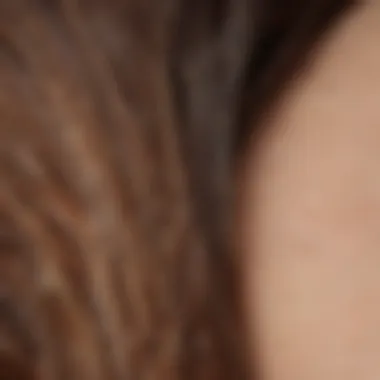Understanding In-Grown Hair Solutions and Tips


Intro
In-grown hairs are a common concern that affects many people, often leading to discomfort and skin irritation. These hairs occur when hair grows back into the skin after shaving, waxing, or tweezing. The condition can lead to unsightly bumps, redness, and even infection. Understanding how to effectively manage this condition is crucial for both personal comfort and grooming satisfaction.
This article will explore the underlying causes of in-grown hairs, discuss various methods for removal, and offer insights into how to prevent them from occurring in the first place. While the quest for smoother skin is a universal goal, the strategies employed must cater to individual skin types and practices.
The discussion will include practical tips on identifying products that work, as well as how altering grooming habits can lead to healthier skin. Ultimately, the goal is to empower readers with the knowledge needed to make informed choices in their grooming routines.
Prelude to In-Grown Hairs
In-grown hairs are a common issue that many individuals encounter. Understanding this condition is crucial for effective hair removal and skincare. The significance of this topic lies in its potential impact on personal grooming satisfaction and overall skin health. When not addressed, in-grown hairs can lead to irritation, inflammation, and sometimes infections. Thus, it is essential to comprehend the reasons behind their occurrence and the various strategies available for removal and prevention. This article aims to equip readers, particularly women of all ages, with insightful knowledge on managing in-grown hairs effectively, benefiting both appearance and comfort.
Definition and Overview
In-grown hairs develop when hair grows back into the skin instead of rising above the surface. This can create red bumps, swelling, and sometimes painful sensations. The hair can become trapped under the skin, leading to further irritation and potential infection. Typically, in-grown hairs are most common in areas where hair is shaved, waxed, or plucked. Educating oneself about this skin condition is vital for making informed decisions about hair removal techniques and skincare products.
Causes of In-Grown Hairs
Several factors contribute to the formation of in-grown hairs. Understanding these causes can aid in prevention and effective treatment. Here are some of the most common reasons:
- Hair Removal Techniques: Shaving and waxing can increase the likelihood of in-grown hairs. Shaving often results in blunt hair edges, which may curl back into the skin.
- Hair Type: Coarser and curly hair types are more prone to in-growing because of their shape and growth patterns.
- Improper Shaving Methods: Using dull blades or shaving against the hair growth can contribute to in-grown hairs.
- Skin Conditions: Certain skin types, especially dry skin, can exacerbate the issue. When the skin is not well-hydrated, it becomes rough, aiding the trapping of hair.
- Tight Clothing: Wearing tight clothing can create friction against the skin, pushing hairs back into the follicle.
Understanding these causes helps inform better grooming practices, minimizing the risk of in-grown hairs.
Common Areas Affected by In-Grown Hairs
Understanding the common areas affected by in-grown hairs is crucial for anyone seeking effective removal methods. Recognizing where in-grown hairs primarily occur helps individuals target their grooming practices more effectively. Certain regions of the body have a higher propensity for in-grown hairs due to friction, hair type, and skin texture. This section will detail these common areas, allowing readers to adapt their routines accordingly.
Facial Region
The facial region is particularly prone to in-grown hairs, especially for individuals who shave or wax. Areas such as the chin, cheeks, and neck are especially vulnerable. In-grown hairs here can lead to irritation, redness, and even infection, causing distress.
The skin on the face is sensitive, making proper shaving techniques essential. Using a clean, sharp razor and shaving in the direction of hair growth reduces the chance of hair curling back into the skin. Regular exfoliation can also be beneficial in preventing in-grown hairs. Consider gentle products that suit sensitive skin to avoid further irritation.
Bikini Line
The bikini line is another common area where in-grown hairs can cause significant discomfort. This is due to the coarse nature of hair in this region and the close-fitting clothing often worn.
Waxing and shaving are the primary hair removal methods used here, but both can lead to in-grown hairs. To minimize this risk, one may choose to trim hairs before removal instead of shaving closely, or consider using specialized wax strips designed for sensitive skin. Exfoliating the bikini line regularly can also prevent hairs from becoming trapped.
Underarms
The underarms are often overlooked when discussing in-grown hairs, yet they are a frequent spot for this issue. The skin here is delicate, and hair removal through shaving can lead to hairs growing inward.
Utilizing a moisturizing shaving cream or gel can help create a barrier that protects the skin. This area also benefits from exfoliation to remove dead skin cells. Regular exfoliation can be done with a soft washcloth or mild scrub, maintaining the smoothness of the skin and decreasing the likelihood of in-grown hairs.
Legs
Legs, particularly the thighs and shins, are expansive areas susceptible to in-grown hairs. Factors like hair type, skin condition, and method of hair removal deeply influence the occurrence of in-grown hairs.
It is important to ensure that hair removal methods are appropriate for the hair type. For example, individuals with coarser hair may consider less frequent shaving and opting for longer-lasting methods like waxing or laser removal. Moreover, always applying a moisturizer after hair removal can help mitigate skin irritation, further reducing the risk of in-grown hairs.
In summary, different body regions have unique characteristics and challenges regarding in-grown hairs. By tailoring grooming practices to specific areas, individuals can greatly enhance their chances of preventing this common issue.
In-Grown Hair Removal Methods
Understanding the various methods for in-grown hair removal is crucial for those grappling with this common issue. Each method offers unique benefits and considerations, providing options that cater to individual preferences and needs. By assessing these techniques, readers can identify the most effective solutions tailored to their skin type and hair growth patterns. The following sections will discuss prominent removal methods and how they may enhance one’s grooming routine.
Tweezing
Tweezing is a popular method for in-grown hair removal, especially for small areas like the eyebrows or chin. It involves using a pair of tweezers to pull the hair out from the root. This technique can be effective for specific occasions where precision is necessary. However, it can also aggravate the skin if done excessively or improperly, leading to more in-grown hairs. Choosing quality tweezers can also enhance the outcomes of this method.
Exfoliation Techniques
Exfoliation plays a significant role in the prevention and treatment of in-grown hairs. It helps remove dead skin cells, allowing trapped hairs to emerge. For effective exfoliation, two primary methods stand out: Physical Exfoliation and Chemical Exfoliation.


Physical Exfoliation
Physical exfoliation involves using scrubs or tools to manually remove dead skin cells. This method is deemed beneficial since it is straightforward and can be done at home. Key characteristics include its immediate effects on the skin’s surface. For those who prefer a hands-on approach, this method feels rewarding as it allows for tangible results.
Advantages:
- Immediate results can be seen.
- Can be combined with other treatments.
Disadvantages:
- May irritate sensitive skin.
- Requires consistency for long-term results.
Chemical Exfoliation
Chemical exfoliation uses products containing acids or enzymes to dissolve dead skin cells. This method can be less abrasive than physical scrubs and may yield deeper efficacy against in-grown hairs. The key characteristic of chemical exfoliation is its ability to penetrate the skin, promoting cell turnover and ultimately offering smoother skin.
Advantages:
- Less risk of irritation for some skin types.
- Can be tailored with different formulations.
Disadvantages:
- Requires understanding of suitable products.
- Potential for over-exfoliation and sensitivity.
Professional Waxing
Professional waxing is another popular method for removing in-grown hairs. This technique involves applying warm wax to the skin, followed by a cloth strip to remove the hair from the root. The benefits of waxing include longer-lasting results compared to shaving and the chance to achieve smooth skin more effectively. However, waxing should be performed by a qualified professional to minimize skin irritation and complications.
Laser Hair Removal
Laser hair removal is an advanced solution that targets hair follicles using concentrated light. This method has gained traction for its long-lasting results, as it significantly reduces hair growth over time. While the upfront costs can be high, many find that the long-term investment pays off by eliminating frequent maintenance. However, it doesn’t suit all hair and skin types, making initial consultations essential.
Over-the-Counter Products
Over-the-counter products represent a convenient way to address in-grown hairs. Among these, creams and gels stand out as effective solutions.
Creams
In-grown hair removal creams often contain key ingredients like salicylic acid or exfoliating agents. These formulas are typically easy to apply and provide targeted treatment for affected areas, making them a beneficial choice. Unique features include their formulated ingredients intended to soothe inflammation and prevent future in-grown hairs.
Advantages:
- Generally easy to use.
- Can be used alongside other methods.
Disadvantages:
- May cause dryness if overused.
- Results can take time.
Gels
Gels serve as another effective means of combating in-grown hairs with lightweight consistency. They often absorb quickly into the skin, providing instant hydration, which helps mitigate any irritation. Their key versatility makes gels a popular choice among users seeking an effective yet gentle solution for sensitive areas.
Advantages:
- Quick absorption and non-greasy finish.
- Ideal for sensitive or acne-prone skin.
Disadvantages:
- May require more frequent application.
- Not all gels are suitable for all skin types.
Understanding and selecting the right method for in-grown hair removal can empower individuals to enjoy smoother skin and reduce discomfort caused by this common grooming problem.
Prevention of In-Grown Hairs
Preventing in-grown hairs is a crucial aspect of maintaining healthy skin and enhancing personal grooming routines. In-grown hairs occur when hair grows back into the skin instead of outward. This often causes discomfort and may lead to inflammation, irritation, or even infection. Understanding and implementing preventative measures can reduce the occurrence of these pesky hairs and contribute to smoother skin.


Proper Shaving Techniques
Using the right shaving techniques can significantly reduce the risk of in-grown hairs. It is essential to use a sharp, clean razor to minimize skin irritation. Applying a warm compress before shaving softens the hair and skin, making the process smoother. Shaving in the direction of hair growth is advisable. This helps to prevent hair from being cut too short, which can lead to it curling back into the skin. Additionally, avoid pressing too hard on the razor. This might cause nicks or irritation, which contribute to in-grown hairs.
Moisturizing Regularly
Choosing the Right Moisturizers
Selecting an appropriate moisturizer is vital in preventing in-grown hairs. A good moisturizer retains skin hydration, reducing dryness and the likelihood of irritation. Look for moisturizers that contain natural ingredients such as aloe vera or shea butter. These components offer soothing properties. Additionally, products free from artificial fragrances and harsh chemicals are preferable, as they minimize the risk of allergic reactions or sensitivity. However, it is important to test a small amount on the skin first, as everyone's skin responds differently to ingredients.
Importance of Hydration
Staying hydrated plays an important role in skin health, which in turn helps prevent in-grown hairs. Drinking sufficient water keeps the skin supple and maintains its elasticity. Hydrated skin is less likely to become dry or irritated, which reduces the chances of hair growing back into the skin. It might sound simple, but ensuring adequate daily fluid intake has numerous benefits for overall skin wellness. Remember to incorporate hydrating foods like fruits and vegetables into the diet too, as they also contribute to better skin health.
Wear Loose Clothing
Choosing loose clothing can have a substantial impact on the prevention of in-grown hairs. Tight-fitting clothes can cause friction against the skin, which may irritate hair follicles and contribute to the problem of in-grown hairs. Opting for breathable fabrics allows the skin to recover and reduces the chances of hair being trapped underneath. Whenever possible, select garments that provide a comfortable fit and avoid restricting movements. This small adjustment in wardrobe choices can support healthier skin and a smoother appearance.
Aftercare for Skin Post Hair Removal
After hair removal, the skin often experiences irritation or sensitivity. Proper aftercare is essential not only to promote healing but also to minimize the risk of challenges such as in-grown hairs and infections. This section will address cleansing, soothing sensitivity, and effective strategies to ensure your skin remains healthy and comfortable post-removal.
Cleansing
Cleansing the skin following hair removal is paramount. It helps to remove any leftover product residues, dead skin cells, and impurities. Gentle cleansers are recommended as they do not strip the skin of its natural oils. Ideally, a mild, alcohol-free cleanser should be used, especially on sensitive areas. By cleansing, the skin can breathe, preventing potential blockages that may lead to in-grown hairs. Aim to clean the area twice daily for optimal results, attending to any signs of irritation or redness immediately.
Soothing Sensitivity
The removal process can sometimes incite discomfort or redness in the skin. To mitigate this, soothing tactics should be employed. Understanding how to nurture your skin can prevent long-term issues and enhance overall comfort.
Using Aloe Vera
Aloe Vera is widely regarded for its skin-soothing properties. Its natural anti-inflammatory effects help reduce redness and swelling. Many people find Aloe Vera to be a popular choice for skin care post hair removal. Its gel form provides a cooling sensation, offering immediate relief. When applied, it not only hydrates but also promotes healing. Furthermore, its natural composition minimizes the likelihood of allergic reactions, making it a beneficial option for sensitive skin.
Advantages of Aloe Vera:
- Contains vitamins and minerals that support skin health.
- Effective at improving skin moisture levels.
- Generally safe for all skin types.
Disadvantages:
- Some individuals may experience irritation if allergic.
Cold Compresses
Cold compresses are another useful remedy post hair removal. They are beneficial for reducing swelling and numb discomfort. Applying a cold compress helps constrict blood vessels, leading to diminished redness and irritation. This method is particularly effective for areas that are prone to inflammation, such as the bikini line or underarms.
Using a cold compress is simple and effective. Just wrap ice or a cold pack in a cloth and apply it gently to the affected area for about 10-15 minutes.
Advantages of Cold Compresses:
- Provides immediate relief to irritated skin.
- Easy to prepare and apply.
- No requirement for additional products.
Disadvantages:
- Not suitable for extensive applications, as prolonged exposure can cause skin damage.
Aftercare plays a crucial role in skin health following hair removal. By incorporating cleansing and soothing techniques, individuals can enhance their recovery while minimizing the risk of complications.
Debunking Myths About In-Grown Hairs
In the realm of personal grooming, in-grown hairs often garner misunderstandings that can lead to ineffective solutions or exacerbated issues. This section aims to clarify common myths surrounding in-grown hairs, highlighting misconceptions and providing factual insights. By debunking these myths, readers can gain a better understanding of effective strategies for prevention and treatment, ultimately leading to healthier skin.
Misconceptions About Hair Growth
In-grown hairs occur when hair curls back into the skin instead of growing outwards. One prevalent misconception is that the thickness and coarseness of body hair are the primary culprits behind in-growing. While it is true that individuals with thicker hair may experience more in-grown hair situations, the primary factor is more about the hair's growth pattern and how the hair removal method affects its trajectory. Additionally, some believe that shaving can make hair grow back thicker. This is not accurate, as shaving merely cuts hair at the surface, and what some perceive as increased thickness is actually a blunt edge of freshly cut hair.


Another common misunderstanding relates to skin type. Many assume that only those with coarse or curly hair are susceptible to in-grown hairs. However, individuals with straight and fine hair can also encounter this issue. Skin irritation from frequent shaving or waxing can lead to in-grown hairs, irrespective of hair type. Recognizing these points can assist in tailoring treatment and prevention efforts according to individual circumstances.
Myths Around Exfoliation
Exfoliation is often touted as the miraculous solution to prevent in-grown hairs. While it's an important part of skincare, there are myths that can mislead individuals about how to effectively exfoliate.
One prevalent myth is that over-exfoliating the skin will solve the problem. In fact, excessive exfoliation can irritate the skin, leading to more inflammation and potentially more in-grown hairs. The key is to strike a balance.
There’s a belief that all exfoliation methods are equal, yet this is not the case. Physical exfoliation, such as scrubs, may provide immediate results but can cause microtears in the skin if used too harshly. Chemical exfoliation via acids can offer a gentler and more effective means to remove dead skin cells without damaging the skin barrier. It’s important to choose the right method tailored to one’s skin type.
Understanding these myths empowers individuals to make informed decisions, ensuring their approach to managing in-grown hairs remains effective. Recognizing that myths can hinder effective treatment is crucial for establishing a successful regimen for skin health. To enhance one's skincare routine, knowledge of both hair growth behavior and exfoliation methods is indispensable.
Consulting Professionals
Seeking professional guidance in managing in-grown hairs is an important step in effective removal and prevention. Professionals like dermatologists and estheticians offer expertise that goes beyond general advice. They can provide tailored solutions based on individual skin types, hair types, and any underlying conditions that may contribute to in-grown hairs. Understanding when to seek their help can lead to better skin health and a significant decrease in discomfort.
When to Seek Help
Consider consulting a professional if you experience persistent in-grown hairs, significant irritation, or signs of infection. If at-home remedies are not yielding results, or if you struggle to manage in-grown hairs despite adhering to preventive measures, it is wise to consult an expert. Moreover, symptoms such as redness, swelling, and pus-filled bumps indicate the need for prompt attention. Getting timely help can prevent complications and ensure your skin remains healthy.
Types of Specialists to Consult
Dermatologists
Dermatologists specialize in skin conditions and are equipped to handle complex cases of in-grown hairs. Their extensive training allows them to diagnose skin concerns and recommend treatments. They often suggest topical prescription medications that can minimize inflammation and help prevent future in-grown hairs. A major advantage of consulting a dermatologist includes access to professional treatments such as extractions and laser therapies. However, the cost of such services may be higher than other options.
Estheticians
Estheticians provide skin care treatments focused on aesthetics. While they are not medical doctors, they can still be valuable for addressing cosmetic concerns related to in-grown hairs. They often perform professional exfoliation and hair removal techniques that can mitigate issues effectively. Their unique feature lies in their approach to overall skin care, which includes facials and other treatments to support skin health. It is important to note that estheticians cannot diagnose skin disorders, so serious conditions should be directed to a dermatologist. Choosing an esthetician can be a good option for routine care and maintenance, particularly if you prefer a more holistic approach.
"Consulting a professional can provide insights and solutions that you may not achieve through home remedies alone."
Lifestyle Factors Influencing In-Grown Hairs
Lifestyle choices play a significant role in the occurrence and severity of in-grown hairs. Understanding these factors can aid in developing effective strategies for prevention and management. Factors like diet, hydration, and stress management can influence skin health, which directly affects the propensity for in-grown hairs. Incorporating awareness of these aspects into your grooming routine can mitigate discomfort and promote smoother skin.
Diet and Nutrition
A balanced diet is crucial for maintaining healthy skin. Nutrients such as vitamins A, C, and E are essential for skin repair and regeneration. A diet rich in antioxidants can help combat inflammation, which may otherwise exacerbate the condition of your skin. Foods like fruits, vegetables, nuts, and whole grains should be staples in your meals.
Additionally, omega-3 fatty acids found in fish like salmon and mackerel can provide anti-inflammatory benefits. On the other hand, processed food and high sugar intake can lead to skin issues, including clogged pores that may contribute to in-grown hairs. Staying mindful of nutritional choices is therefore vital.
Hydration and Skin Health
Hydration is another fundamental aspect of skin health. Dehydrated skin can become dry and flaky, leading to an increase in irritation during hair removal processes. Drinking adequate water helps maintain skin elasticity and reduces the likelihood of hairs becoming trapped beneath the surface.
Moreover, applying moisturizers can restore the skin's moisture barrier. Choose products that contain ingredients like glycerin and hyaluronic acid. These ingredients attract water to the skin and keep it hydrated. Regular moisturizing can also soothe existing irritation and can be a key factor in maintaining smooth skin post hair removal.
Stress and Hormonal Changes
Stress has a profound impact on overall wellness, including skin health. High stress levels can lead to hormonal changes that may cause skin problems. Conditions like acne and possibly even increased occurrences of in-grown hairs can arise under stress. Finding effective stress management techniques is essential. Consider methods such as meditation, yoga, or regular exercise to keep stress levels in check.
Hormones also influence hair growth cycles. Changes in hormones, such as those experienced during menstruation or pregnancy, can lead to hair becoming more prone to in-growing. Keeping a balanced lifestyle and recognizing how stress and hormonal stability affect your skin can provide insights necessary for prevention and management of in-grown hairs.
End
In this article, the significance of addressing in-grown hairs has been thoroughly examined. In-grown hairs are not merely a cosmetic issue; they can lead to physical discomfort and sometimes, skin irritation or infections. Understanding how to prevent and manage them is essential for maintaining skin health. This insight allows individuals to make informed choices about their grooming routines.
Recap of Key Points
In summary, there are several crucial takeaways regarding in-grown hairs and their management:
- Causes of in-grown hairs are often linked to improper shaving and hair removal methods. Factors like curly hair texture and occlusive clothing can exacerbate this issue.
- Removal Methods such as tweezing, exfoliation, professional waxing, and laser treatments provide various options tailored to individual needs. They all come with specific benefits and considerations that must be weighed.
- Prevention plays a critical role, involving proper shaving techniques, regular moisturizing, and wearing loose clothing to minimize friction.
- Aftercare is equally important, with options to cleanse and soothe the skin post hair removal.
- Lifestyle factors, like diet and stress management, can influence skin health and, consequently, in-grown hairs.
This holistic approach underscores the importance of integrated care for the skin.
Final Thoughts
The issue of in-grown hairs is complex yet manageable. By understanding the root causes and employing effective removal and prevention strategies, individuals can significantly improve their skin's appearance and comfort. Ongoing education about personal grooming can lead to lasting benefits, both aesthetically and health-wise. It's essential to not only address immediate concerns but to maintain a proactive approach in skincare.
Engaging with specialists, when necessary, can provide further insights that are tailored to your specific needs. The journey to healthier skin is continuous and involves adapting to changes in individual skin conditions or lifestyle choices. By committing to the practices recommended in this guide, readers can foster a healthier relationship with their skin and enjoy the comfort of smooth skin.

